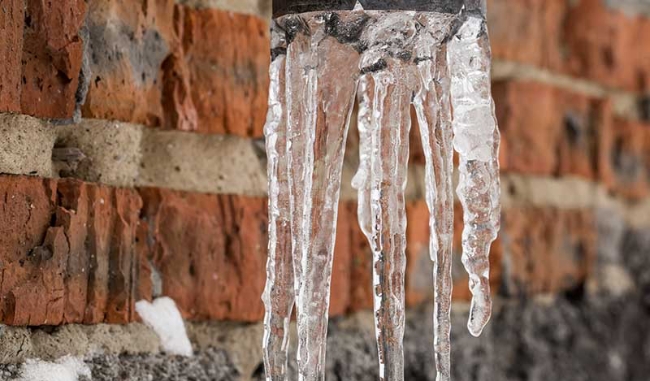Preventing Pipes from Cold Weather: Best Tips
Preventing Pipes from Cold Weather: Best Tips
Blog Article
We've come across this post relating to How to Prevent Your Pipes From Freezing directly below on the web and decided it made perfect sense to discuss it with you here.

Cold weather can wreak havoc on your plumbing, especially by freezing pipelines. Right here's exactly how to avoid it from happening and what to do if it does.
Introduction
As temperatures drop, the threat of icy pipes increases, possibly bring about expensive repair services and water damage. Recognizing how to avoid frozen pipelines is critical for house owners in chilly environments.
Prevention Tips
Insulating at risk pipelines
Cover pipes in insulation sleeves or make use of warmth tape to secure them from freezing temperature levels. Concentrate on pipes in unheated or external locations of the home.
Home heating techniques
Maintain indoor areas appropriately warmed, particularly locations with pipes. Open cabinet doors to permit cozy air to circulate around pipelines under sinks.
Exactly how to identify icy pipes
Look for reduced water circulation from faucets, uncommon odors or noises from pipelines, and visible frost on revealed pipes.
Long-Term Solutions
Architectural modifications
Take into consideration rerouting pipelines away from exterior wall surfaces or unheated locations. Include added insulation to attic rooms, cellars, and crawl spaces.
Updating insulation
Invest in premium insulation for pipes, attics, and wall surfaces. Appropriate insulation helps maintain regular temperatures and decreases the threat of frozen pipes.
Shielding Outside Plumbing
Yard hose pipes and exterior faucets
Separate and drain yard pipes before winter months. Install frost-proof faucets or cover outdoor faucets with insulated caps.
Comprehending Icy Pipelines
What creates pipelines to ice up?
Pipelines freeze when exposed to temperature levels listed below 32 ° F (0 ° C) for prolonged durations. As water inside the pipes freezes, it broadens, putting pressure on the pipeline wall surfaces and potentially creating them to burst.
Risks and damages
Icy pipelines can result in water system interruptions, home damages, and pricey repairs. Burst pipes can flood homes and trigger comprehensive structural damages.
Indications of Frozen Pipes
Recognizing frozen pipes early can avoid them from bursting.
What to Do If Your Pipelines Freeze
Immediate actions to take
If you believe frozen pipelines, keep taps available to relieve stress as the ice thaws. Utilize a hairdryer or towels taken in hot water to thaw pipelines gradually.
Final thought
Avoiding frozen pipelines calls for proactive procedures and fast responses. By comprehending the reasons, signs, and preventive measures, house owners can shield their plumbing during cold weather.
5 Ways to Prevent Frozen Pipes
Drain Outdoor Faucets and Disconnect Hoses
First, close the shut-off valve that controls the flow of water in the pipe to your outdoor faucet. Then, head outside to disconnect and drain your hose and open the outdoor faucet to allow the water to completely drain out of the line. Turn off the faucet when done. Finally, head back to the shut-off valve and drain the remaining water inside the pipe into a bucket or container. Additionally, if you have a home irrigation system, you should consider hiring an expert to clear the system of water each year.
Insulate Pipes
One of the best and most cost-effective methods for preventing frozen water pipes is to wrap your pipes with insulation. This is especially important for areas in your home that aren’t exposed to heat, such as an attic. We suggest using foam sleeves, which can typically be found at your local hardware store.
Keep Heat Running at 65
Your pipes are located inside your walls, and the temperature there is much colder than the rest of the house. To prevent your pipes from freezing, The Insurance Information Institute suggests that you keep your home heated to at least 65 degrees, even when traveling. You may want to invest in smart devices that can keep an eye on the temperature in your home while you’re away.
Leave Water Dripping
Moving water — even a small trickle — can prevent ice from forming inside your pipes. When freezing temps are imminent, start a drip of water from all faucets that serve exposed pipes. Leaving a few faucets running will also help relieve pressure inside the pipes and help prevent a rupture if the water inside freezes.
Open Cupboard Doors
Warm your kitchen and bathroom pipes by opening cupboards and vanities. You should also leave your interior doors ajar to help warm air circulate evenly throughout your home.

I recently found that page on 6 Ways to Prevent Frozen Pipes while browsing the internet. If you please take the opportunity to distribute this post if you enjoyed reading it. Many thanks for your time. Come back soon.
Click Here Report this page